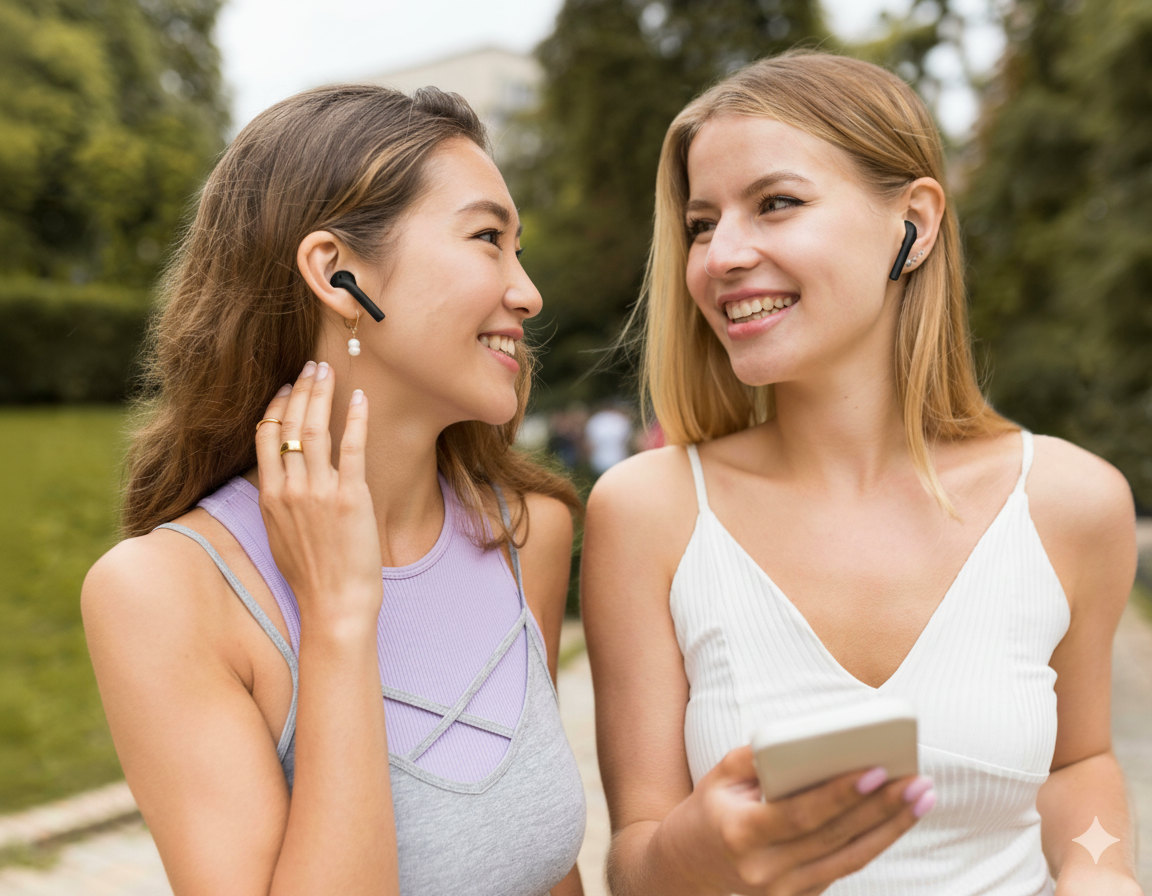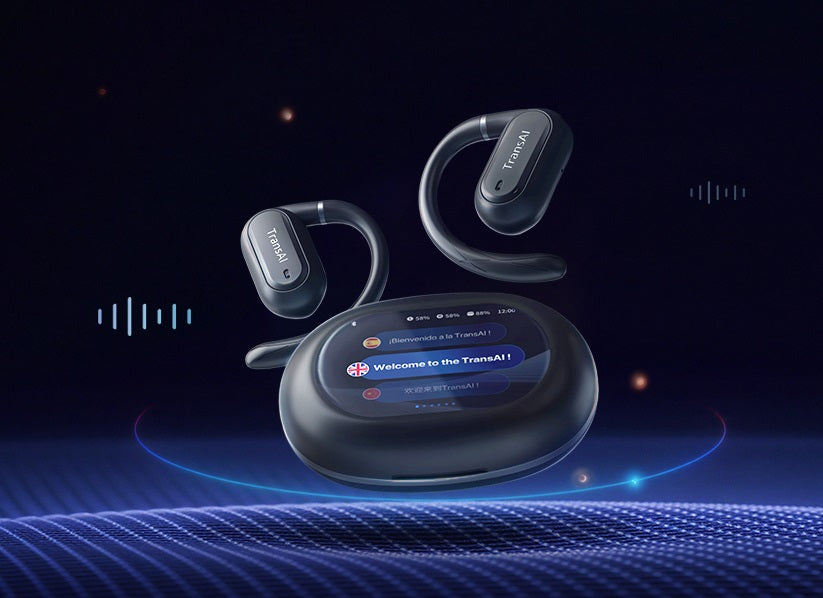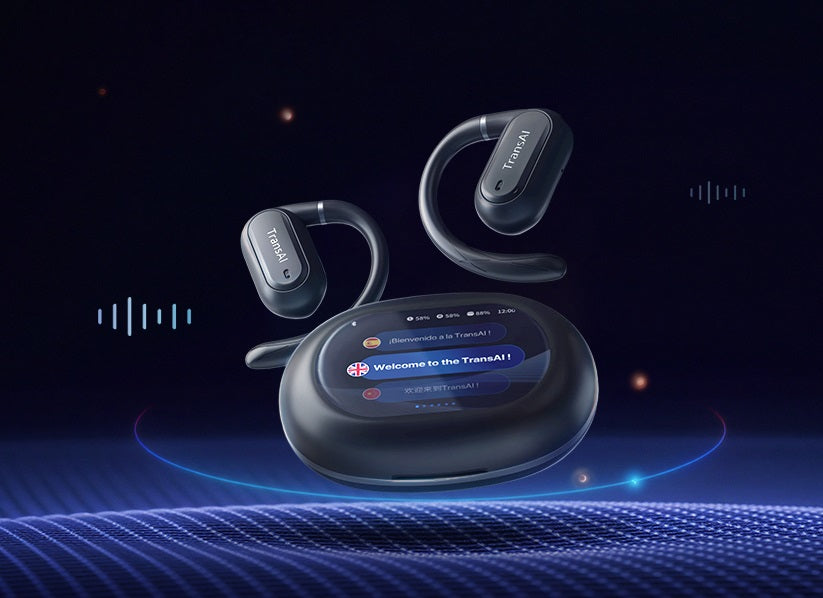你知道那種情況嗎?當你在國外旅行時,有人用一種你幾乎聽不懂的語言問你問題?對大多數人來說,那一刻的尷尬停頓是無法避免的。但如果你能立刻、自然地回答,就像你真的會說那種語言一樣呢?這正是翻譯耳機所能實現的——老實說,那感覺就像科幻電影中的情節變成了現實。
讓我們一起來看看這些聰明的裝置是如何運作的——以及為什麼它們不只是你耳中的小玩意兒。
翻譯耳機是如何運作的?

從根本上來說,翻譯耳機結合了麥克風、AI 驅動的語音辨識以及即時翻譯軟體,以彌合溝通的鴻溝。整個過程只需幾秒鐘,讓對話感覺自然而流暢。
步驟一:捕捉你的聲音
一切從「聆聽」開始。翻譯耳機內建了能清晰拾取語音的麥克風,即使在像咖啡廳、機場或繁忙街道等嘈雜環境中也能清楚收音。有些耳機(例如 TransAI GO1)甚至配備了雙麥克風,以更好地將你的聲音與背景噪音分離——這樣就不會因為旁邊有人按喇叭而出現尷尬的誤譯。
在這個階段,你的語音會被轉換成數位音訊訊號,接著由耳機內部系統處理,或傳送到你的手機。可以把它想像成耳機在「聽懂」你說的話。
步驟二:語音辨識(將語音轉換為資料)
當耳機捕捉到你的聲音後,它會使用語音辨識技術——基本上就是一個由 AI 驅動的「聽者」,能將語音轉譯成文字。
這一步非常關鍵。耳機必須準確理解你所說的每個字,包括語氣、口音以及細微的語調。有些裝置甚至能處理多種口音或方言,因此帶有法國口音的英語也不會讓翻譯系統混亂。
這就像在你耳邊有一位超快速、看不見的語言學家,在將每個字都記錄下來後再交給下一步處理。
步驟三:即時翻譯
真正的魔法就在這裡發生。當語音被轉譯成文字後,耳機(或有時是連接的應用程式)會利用AI 翻譯演算法,即時將文字轉換成另一種語言。
現代翻譯耳機(如 TransAI GO1)支援150 多種語言與口音,幾乎能應對任何情境——面對面交談、電話或 WhatsApp、FaceTime 等視訊通話。翻譯結果經過優化,聽起來自然而非機械,讓對話更流暢。
步驟四:傳遞翻譯結果
翻譯完成後,耳機會以語音、文字或兩者兼具的方式回饋結果:
-
語音輸出:你可以幾乎即時地在耳中聽到翻譯後的語音。
-
即時字幕:有些裝置(如 TransAI 耳機)會在小型 LED 顯示器或手機螢幕上顯示即時字幕——非常適合在嘈雜環境中使用或當需要更清晰理解時。
這種雙重輸出確保你能理解內容,而對方也會覺得你真的會說他們的語言。
步驟五:提升溝通的智慧功能
現代翻譯耳機不僅僅是翻譯工具,它們還具備以下功能:
-
多種對話模式:包括聆聽模式、自由對話模式與觸控模式,以適應不同交流情境。
-
電話與視訊通話翻譯:某些耳機甚至可即時翻譯通話,讓你能與世界各地的親友或同事交流無障礙。
-
降噪與自適應麥克風:即使在車站或熱鬧的市集中,也能保持翻譯的準確度。
總的來說,這些耳機就像你的私人口譯員,隨時在聆聽、翻譯並即時回饋。
翻譯耳機真的好用嗎?
你可能會想:「聽起來很厲害——但實際上真的好用嗎?」老實說,這是個價值百萬的問題。答案是……大部分情況下都有效,但也有些限制。
翻譯耳機依靠語音辨識與 AI 驅動的翻譯技術,能即時將語音轉換成另一種語言。在許多情況下——像是出國旅行、與外國人閒聊或簡單商務交流——效果都相當不錯。
然而,其準確度仍可能受影響。背景噪音、語速過快、強烈口音或複雜成語都可能導致誤譯。它們還稱不上完美的人類口譯員,細微的語氣或幽默感有時可能無法完全還原。
儘管如此,對於日常使用而言,翻譯耳機能大幅減少語言障礙。當使用者清晰且適中地說話時,AI 就能獲取足夠語境,產生準確的翻譯。
這裡有個實用小技巧:說話要清楚,但自然。不需要刻意咬字或放慢速度——像平常一樣說話即可。耳機會幫你處理剩下的部分,輕鬆跨越語言隔閡。
總而言之,雖然翻譯耳機不是完美的,但在旅行、日常或非正式商務場景中,它們確實是非常實用的溝通輔助工具。
為什麼這感覺像魔法一樣
當你真正使用翻譯耳機時,很容易忘記背後的高科技。你只需開口說話,對方就能理解你——即使你完全不懂他們的語言。整個過程流暢、快速,令人驚訝地自然。
老實說,這是那些讓世界變得更小、更友善的小型科技飛躍之一。
重點總結
翻譯耳機透過語音辨識、AI 翻譯與智慧輸出系統的結合,在即時中運作。像TransAI GO1 這類裝置更進一步,支援電話與視訊翻譯、多對話模式及即時字幕,讓跨語言交流變得毫不費力。
所以下次當你旅行、國際洽談,或與世界另一端的人聊天時,記得:你的小耳機不僅在聆聽,它正在連結世界。



留言
此網站已受到 hCaptcha 保護,且適用 hCaptcha 隱私政策以及服務條款。